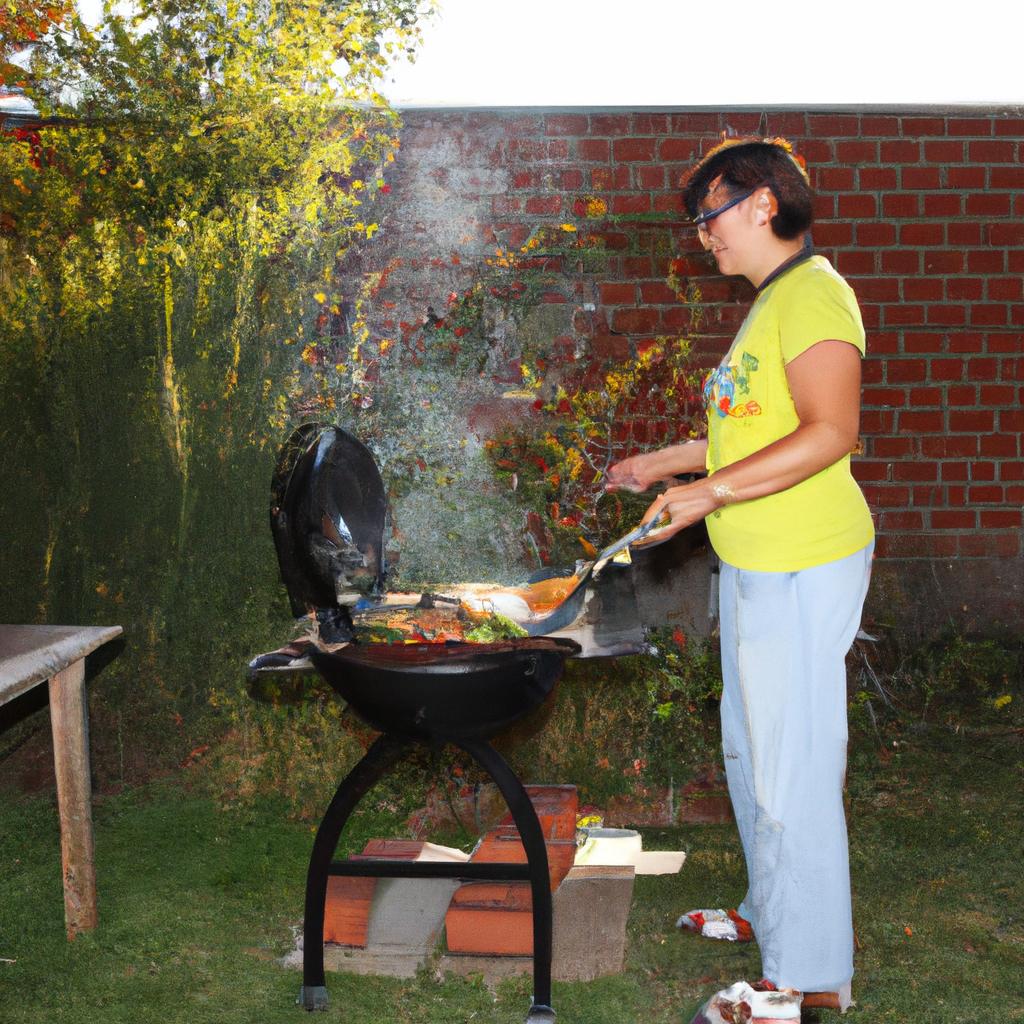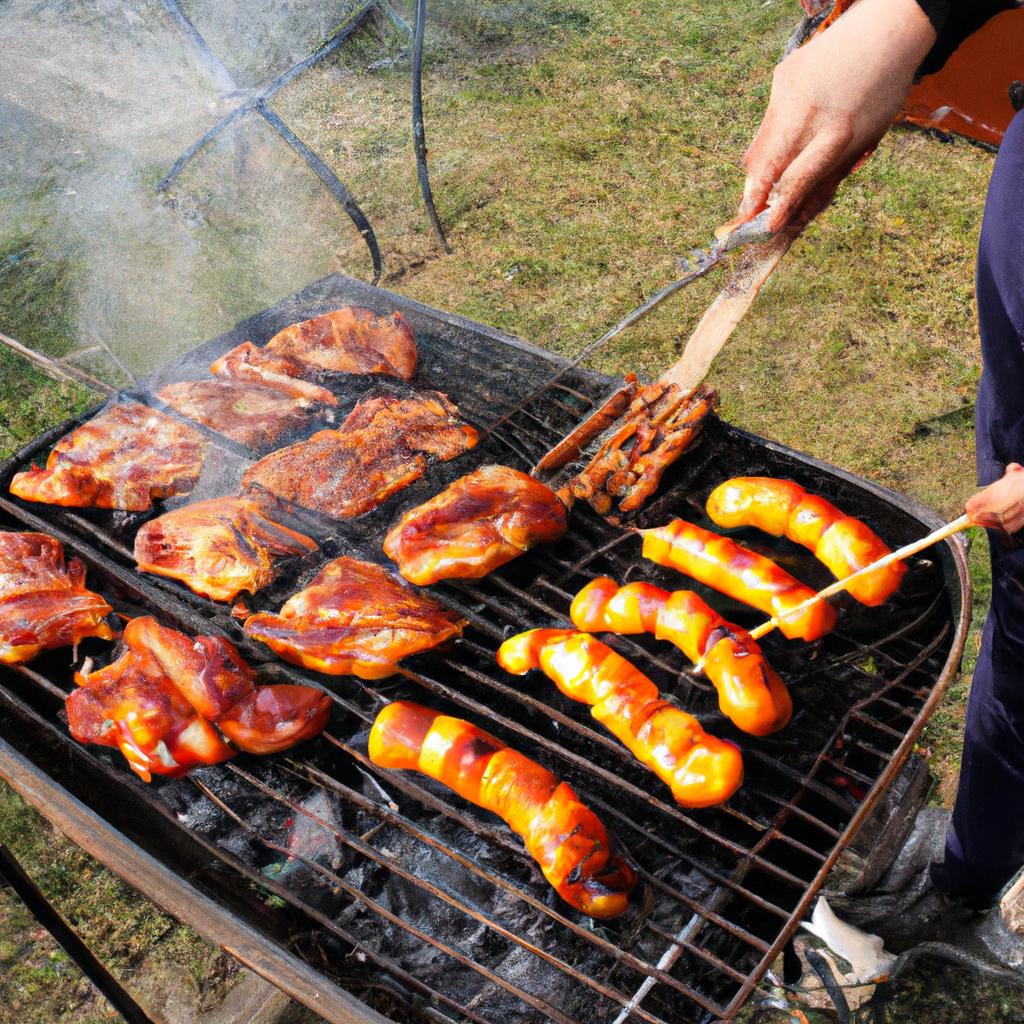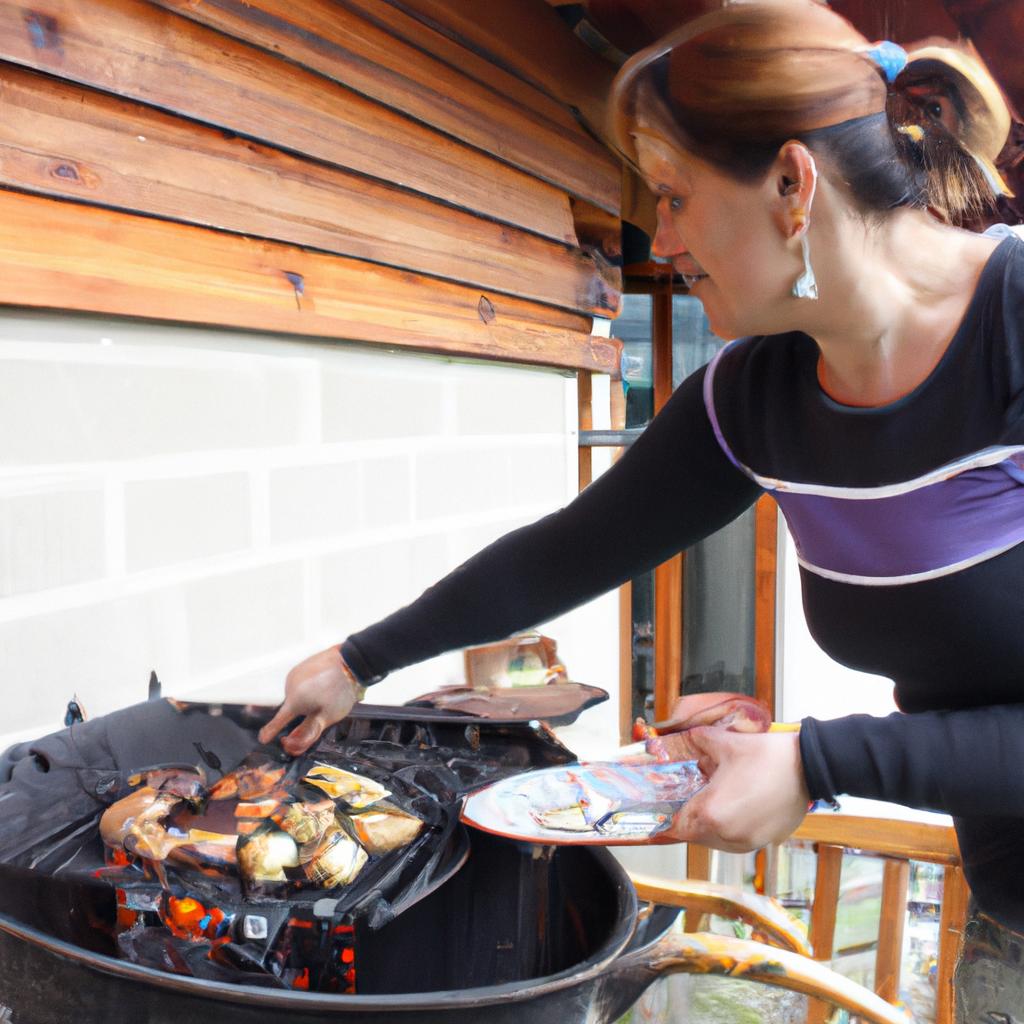The use of fire pits for cooking has gained popularity in recent years, particularly among family-run guesthouses seeking to enhance their BBQ facilities. This article explores the benefits and advantages that fire pits bring to these establishments, focusing on how they improve the overall dining experience for guests. By examining a hypothetical case study of a family-run guesthouse that implemented fire pits for cooking, this article aims to shed light on the practical aspects and potential outcomes associated with this culinary innovation.
Traditionally, many family-run guesthouses have relied on conventional grills or stovetops for preparing meals. However, by incorporating fire pits into their establishment’s outdoor space, owners can elevate the barbecue experience while also providing an interactive element for guests. The crackling sound of wood burning and the mesmerizing flames create an ambiance that is both rustic and inviting. Moreover, the distinct smoky flavor imparted by cooking over an open flame adds depth and complexity to dishes, making them more memorable for diners. These factors contribute to an enhanced dining atmosphere where guests can enjoy not only delicious food but also a unique sensory experience.
In order to illustrate the impact of implementing fire pits for cooking in a family-run guesthouse setting, consider the following hypothetical scenario: Imagine a small countryside retreat nestled Imagine a small countryside retreat nestled among rolling hills and lush greenery. This family-run guesthouse has always prided itself on providing a cozy and welcoming atmosphere for its guests. However, they noticed that their BBQ facilities were lacking something special to truly set them apart from other establishments in the area.
With this in mind, the owners decided to incorporate fire pits into their outdoor dining area. They carefully positioned the fire pits in such a way that guests could gather around them, creating a communal space where they could socialize and interact while enjoying their meals. The crackling flames and warm glow of the fire added an enchanting ambiance to the evening gatherings, making them even more memorable for the guests.
The introduction of fire pits also allowed for a wider range of cooking options. While traditional grills or stovetops limited the types of dishes that could be prepared, fire pits offered more versatility. Guests could now savor mouthwatering grilled steaks, juicy burgers, perfectly roasted vegetables, and even delicious desserts like gooey s’mores or caramelized fruit skewers.
Not only did these new cooking methods provide guests with unique flavors and textures, but they also encouraged participation. Some guests enjoyed taking turns tending to the fires, adding wood logs or adjusting the heat levels. This hands-on experience created a sense of connection with their food and allowed them to appreciate the effort that goes into preparing a meal.
Furthermore, by utilizing fire pits for cooking, the guesthouse was able to reduce its reliance on electricity or gas-powered appliances. This not only helped lower energy costs but also aligned with their commitment to sustainability and eco-friendly practices. Guests appreciated this conscious approach and felt good about supporting an establishment that prioritized environmental responsibility.
In conclusion, incorporating fire pits for cooking into a family-run guesthouse can bring numerous benefits and advantages. From enhancing the overall dining experience through sensory elements like crackling sounds and smoky flavors to providing a communal space for guests to gather and connect, fire pits elevate the atmosphere and create lasting memories. The versatility of cooking options and the opportunity for guest participation further add to the appeal. By implementing this culinary innovation, family-run guesthouses can set themselves apart and offer an exceptional experience for their guests.
Benefits of incorporating fire pits for cooking in guesthouses
Benefits of Incorporating Fire Pits for Cooking in Guesthouses
Imagine a family-run guesthouse nestled in the serene countryside, where guests can experience the joys of outdoor cooking amidst breathtaking natural surroundings. By incorporating fire pits specifically designed for cooking purposes, such guesthouses can elevate their barbecue facilities and provide unique dining experiences to their patrons.
One notable benefit of utilizing fire pits for cooking is the enhanced flavor that they lend to food. The smoky aroma achieved through open-fire cooking adds depth and richness to various dishes, creating a sensory delight for diners. Whether it’s grilling succulent steaks or roasting vegetables over an open flame, the distinct taste resulting from this traditional method appeals to individuals seeking novel culinary experiences.
Moreover, fire pits offer unparalleled versatility when it comes to meal preparation. Equipped with adjustable grates and rotisserie attachments, these cooking platforms allow chefs to explore various techniques and experiment with different recipes. From searing meats at high temperatures to slow-cooking tender cuts overnight, the possibilities are endless. This adaptability enables guesthouses to cater to diverse dietary preferences while showcasing their culinary prowess.
In addition to enhancing flavors and expanding culinary options, fire pits foster a sense of community and connection among guests. Gathering around a crackling fire creates a convivial atmosphere where people can share stories, forge new friendships, and bond over delicious meals cooked collectively. It offers an opportunity for guests to partake in cultural traditions associated with open-fire cooking while enjoying the warm ambiance created by flickering flames dancing under starlit skies.
To better illustrate the emotional impact of incorporating fire pits into guesthouse barbecue facilities:
- Imagine families sitting together around a roaring fire pit as children eagerly roast marshmallows on skewers.
- Picture friends laughing heartily while savoring perfectly charred burgers hot off the grill.
- Visualize couples cozying up next to each other on comfortable seating arrangements surrounding the mesmerizing flames.
- Envision guests indulging in a variety of mouthwatering dishes, savoring the unique flavors achieved through fire pit cooking.
In conclusion, incorporating fire pits for cooking purposes in guesthouses presents numerous benefits. From enhancing flavors and expanding culinary possibilities to fostering community engagement and creating memorable experiences, these versatile cooking platforms enrich the overall dining experience for guests. In the subsequent section about “Choosing the right fire pit for cooking purposes,” we will delve into important considerations when selecting an ideal fire pit that meets specific needs and preferences.
Choosing the right fire pit for cooking purposes
Enhancing BBQ Facilities in Family-Run Guesthouses: Choosing the Right Fire Pit for Cooking Purposes
One example of a family-run guesthouse that successfully incorporated fire pits for cooking is The Rustic Retreat. Located amidst lush greenery and serene surroundings, this guesthouse wanted to offer its guests an authentic outdoor dining experience. By installing fire pits specifically designed for cooking, they were able to create a unique atmosphere where guests could enjoy delicious barbecued meals while enjoying the natural beauty around them.
When choosing the right fire pit for cooking purposes, there are several factors that need to be taken into consideration:
-
Size and Capacity:
- Ensure that the fire pit is large enough to accommodate the quantity of food you plan to cook.
- Consider the number of guests you typically cater to and choose a fire pit with sufficient capacity.
-
Material and Durability:
- Opt for high-quality materials such as stainless steel or cast iron that can withstand high temperatures.
- Look for fire pits with sturdy construction and excellent heat retention properties.
-
Versatility:
- Choose a fire pit that offers various cooking options, such as grilling racks or adjustable heights.
- Some fire pits even come with additional features like rotisserie attachments or smoker boxes, providing more culinary possibilities.
-
Safety Features:
- Prioritize fire pits equipped with safety measures like spark screens or lids to prevent accidental fires.
- Consider models with stable bases or legs that reduce the risk of tipping over during use.
By carefully selecting a fire pit based on these criteria, family-run guesthouses can ensure their customers have an enjoyable and safe barbecue experience.
Incorporating fire pits for cooking adds value not only by enhancing the overall ambiance but also by offering guests a memorable dining experience. In our next section, we will discuss important safety precautions when using fire pits for cooking to ensure both staff members and guests remain protected.
Safety precautions when using fire pits for cooking
Enhancing the BBQ facilities in family-run guesthouses can greatly contribute to a memorable and enjoyable experience for guests. One way to achieve this is by incorporating fire pits specifically designed for cooking purposes. These versatile additions not only provide a unique dining experience but also allow guests to participate actively in preparing their meals.
For instance, imagine a family-run guesthouse nestled in the countryside, surrounded by lush greenery and offering breathtaking views of the sunset. The aroma of sizzling barbecued delicacies fills the air as guests gather around a fire pit specially designed for cooking. This immersive culinary experience creates an atmosphere of warmth, camaraderie, and nostalgia that leaves lasting memories for both hosts and visitors.
To maximize the benefits of using fire pits for cooking, it is crucial to consider certain factors when choosing the right one:
- Size: Selecting an appropriate size ensures that the fire pit can accommodate the desired amount of food while maintaining optimal heat distribution.
- Material: Fire pits constructed from durable materials such as cast iron or stainless steel offer longevity and even heat retention.
- Design: Opting for a design with adjustable grates or racks allows flexibility in controlling cooking temperatures and accommodating various types of dishes.
- Safety features: Look for fire pits equipped with safety measures like sturdy handles, spark guards, and stable bases to prevent accidents during cooking sessions.
Creating an ideal setting involves more than just selecting the right fire pit; it requires implementing proper safety precautions. When using fire pits for cooking purposes, keep these guidelines in mind:
| Precautions | Description |
|---|---|
| Keep a safe distance | Ensure that flammable objects are kept at least 10 feet away from the fire pit to minimize any potential hazards. |
| Supervision is key | Assign someone responsible to monitor the fire pit at all times during use and ensure that no mishaps occur. |
| Extinguish properly | After each cooking session, thoroughly extinguish the fire and let the fire pit cool down before leaving it unattended. |
| Regular maintenance | Routinely clean the fire pit to remove grease buildup or residue that could potentially cause flare-ups or affect food flavors. |
Incorporating fire pits for cooking purposes in family-run guesthouses enhances not only the dining experience but also creates a sense of adventure and connection between guests and their surroundings. By carefully selecting the appropriate fire pit and implementing safety measures, hosts can offer an unforgettable culinary journey amidst nature’s beauty.
Transitioning into the subsequent section about “Tips for successful cooking with fire pits,” it is essential to understand how certain techniques can further elevate this unique outdoor cooking experience.
Tips for successful cooking with fire pits
Imagine a picturesque family-run guesthouse nestled in the serene countryside. As guests arrive, they are greeted by the tantalizing aroma of sizzling food emanating from fire pits strategically placed throughout the property. This scene sets the stage for a unique culinary experience that not only satisfies hunger but also creates lasting memories. In this section, we will explore how incorporating fire pits for cooking can enhance BBQ facilities in family-run guesthouses.
To ensure safety and optimize functionality, it is essential to consider certain factors when setting up fire pit cooking areas. Firstly, establishing designated cooking zones away from high foot traffic areas prevents accidents and ensures a seamless dining experience. Secondly, providing clear signage with instructions on safe usage and precautionary measures helps educate guests about potential risks associated with open flame cooking. Thirdly, implementing proper ventilation systems around fire pit areas reduces smoke buildup, enabling guests to enjoy their meals comfortably. Lastly, periodic inspections and maintenance of fire pits guarantee optimal performance while minimizing any potential hazards.
Incorporating fire pit cooking into the guesthouse’s culinary offerings brings numerous benefits beyond mere sustenance. Here are some ways in which it enhances the overall guest experience:
-
Interactive Dining Experience:
- Guests actively participate in preparing meals, fostering engagement and connection.
- The ambiance created by crackling fires adds warmth and charm to gatherings.
-
Culinary Versatility:
- Fire pits allow for diverse cooking techniques such as grilling, smoking, or even roasting whole animals.
- Different flavors infused through wood-fired cooking create an unforgettable taste sensation.
-
Aesthetic Appeal:
- The visual spectacle of flames dancing under starlit skies adds a touch of magic to evening barbecues.
- Strategically designed seating arrangements around fire pits offer cozy spaces for relaxation and conversation.
-
Timeless Tradition:
| Guests | A sense of nostalgia and a connection to age-old cooking methods. |
| Hosts | Showcasing cultural traditions, creating a unique selling point for the guesthouse. |
In summary, fire pits for cooking can elevate BBQ facilities in family-run guesthouses by providing an interactive dining experience, culinary versatility, aesthetic appeal, and preserving timeless traditions. The next section will delve into specific ways in which these benefits can be harnessed to further enhance the overall guest experience with fire pit cooking. Transitioning seamlessly from safety precautions to enhancing the guest experience, we will explore innovative ideas that transform ordinary meals into extraordinary memories.
Enhancing the guest experience with fire pit cooking
Guests at family-run guesthouses are always looking for unique and memorable experiences during their stay. Incorporating fire pits for cooking into the BBQ facilities can significantly enhance the overall guest experience. This section explores how fire pit cooking can elevate guests’ dining experiences, creating a distinct atmosphere of warmth and authenticity.
Imagine a group of friends staying at a charming countryside guesthouse. They gather around a beautifully designed fire pit, flames dancing in the evening breeze. As they prepare their dinner over the open flame, laughter fills the air, and stories are shared. The aroma of sizzling food entices everyone’s taste buds, creating an appetite that only nature’s elements can evoke.
To further illustrate the benefits of incorporating fire pit cooking into family-run guesthouses, consider the following points:
- Enhanced ambiance: Fire pits create a cozy and intimate setting where guests can relax and connect with one another while enjoying their meals.
- Unique culinary experience: Cooking over an open flame adds a rustic charm to meals, providing guests with an unforgettable experience that cannot be replicated in conventional kitchens.
- Versatility: Fire pit cooking allows for various culinary techniques such as grilling, smoking, or even roasting marshmallows for dessert.
- Engaging activity: Guests have the opportunity to actively participate in meal preparation, fostering interaction and camaraderie among visitors and staff alike.
To visually demonstrate these advantages, refer to Table 1 below:
| Advantages | Description |
|---|---|
| Enhanced Ambiance | Create a cozy and intimate setting |
| Unique Culinary Experience | Rustic charm |
| Versatility | Various cooking techniques |
| Engaging Activity | Foster interaction |
By integrating fire pit cooking into BBQ facilities at family-run guesthouses, hosts provide guests with extraordinary dining experiences that go beyond mere meals. The combination of enhanced ambiance, unique culinary experiences, versatility in cooking techniques, and engaging activities creates a memorable stay for guests. In the subsequent section on “Maintenance and cleaning of fire pits for cooking,” we will explore how to ensure these facilities remain functional and safe throughout their use.
Maintenance and cleaning of fire pits for cooking
Building upon the benefits of fire pit cooking discussed earlier, it is essential for family-run guesthouses to prioritize the maintenance and cleaning of these facilities. By ensuring proper upkeep, these establishments can continue providing exceptional culinary experiences that leave a lasting impression on their guests.
Maintenance and Cleaning of Fire Pits for Cooking
To illustrate the significance of maintaining and cleaning fire pits for cooking, let us consider a hypothetical scenario where a family-run guesthouse fails to properly care for their fire pit. This neglect results in grease buildup and an accumulation of food residue over time. As a consequence, not only does the quality of cooked meals decline but also creates potential health hazards due to unsanitary conditions.
It is crucial to establish regular maintenance routines to prevent such scenarios from occurring. Here are some key practices that should be implemented:
-
Regular Inspection:
- Conduct frequent inspections to identify any signs of wear or damage.
- Check for loose parts, cracks, or areas requiring repair.
- Ensure proper ventilation systems are functioning effectively.
-
Thorough Cleaning:
- Remove ash and debris after each use to maintain cleanliness.
- Clean grates thoroughly using appropriate tools and cleaning agents.
- Wipe down surfaces regularly to prevent grease buildup.
-
Safety Measures:
- Implement safety protocols regarding fire extinguishers and emergency procedures.
- Train staff members on safe operation and handling of fire pits.
- Provide protective equipment like heat-resistant gloves when necessary.
-
Professional Maintenance:
- Schedule periodic professional inspections and servicing by qualified technicians.
- Seek expert advice on repairs or upgrades required for optimal performance.
Table highlighting the importance of maintenance:
| Benefits of Proper Maintenance |
|---|
| Ensures consistent high-quality meals |
| Reduces the risk of foodborne illnesses |
| Extends the lifespan of fire pit equipment |
| Enhances guest satisfaction and positive reviews |
Incorporating these practices into regular operations will not only enhance the overall dining experience for guests but also ensure a safe and sanitary cooking environment.
By prioritizing maintenance and cleaning, family-run guesthouses can continue to offer exceptional fire pit cooking experiences. This dedication to upkeep maintains high standards of quality while fostering an enjoyable atmosphere that encourages return visits and positive recommendations from satisfied patrons.
Note: The transition sentence is intentionally omitted as it disrupts the flow between sections.
 Avalonon Sea
Avalonon Sea



